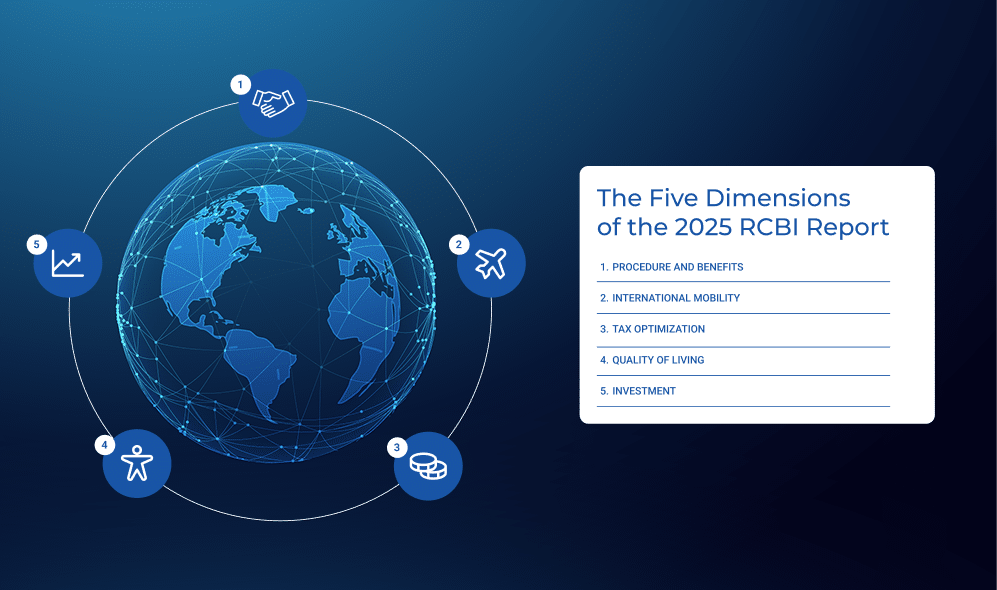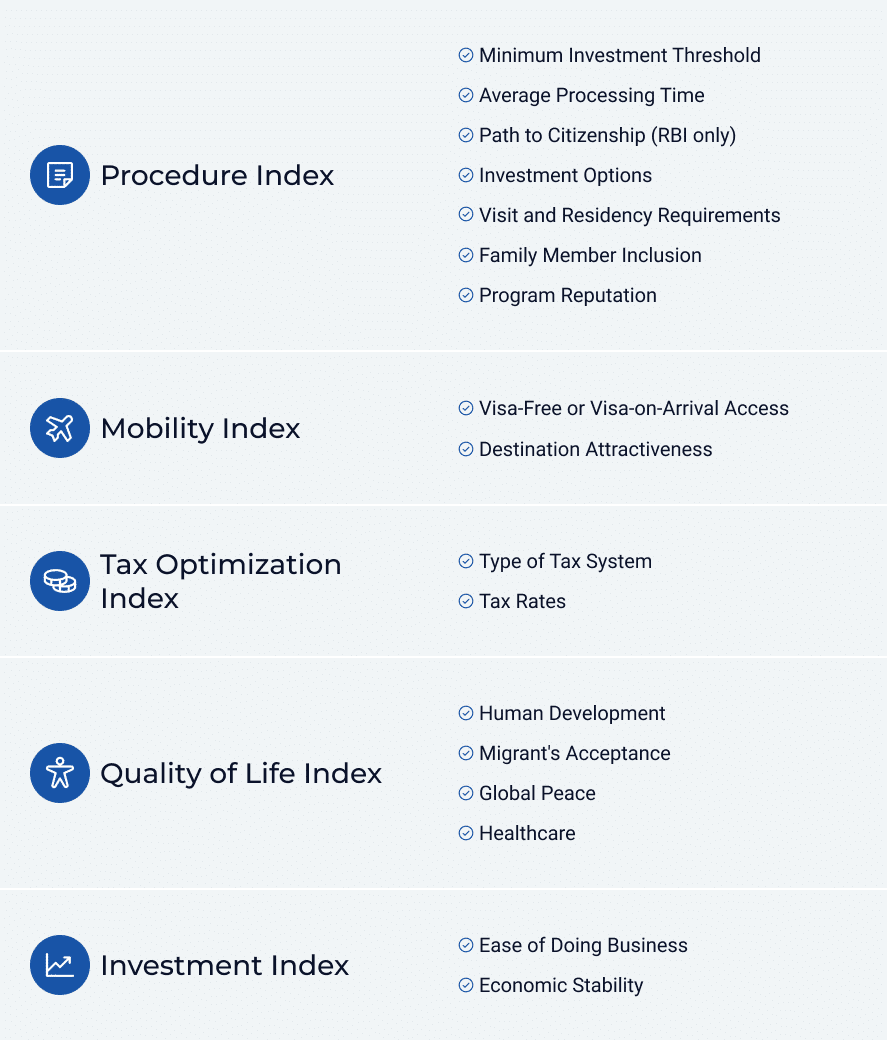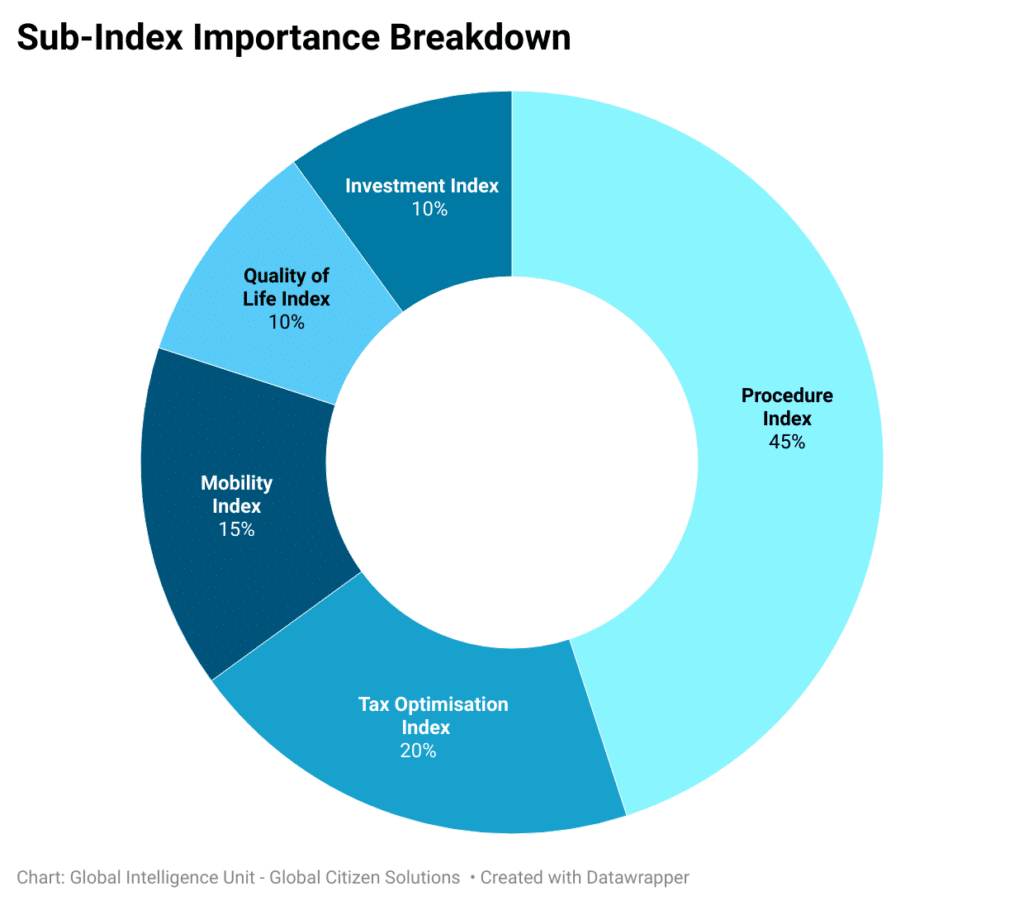Global Residency and Citizenship by Investment Report: Methodology

Table of Contents
Introduction
The Global RCBI Report 2025 offers the most comprehensive, data-driven assessment of the global Residence and Citizenship by Investment (RCBI) landscape to date. Analyzing 36 programs across 22 countries, the report ranks both Citizenship by Investment (CBI) and Residence by Investment (RBI) schemes using a rigorous methodology built on 18 targeted indicators, grouped into five thematic sub-indexes or dimensions: Procedure Index, Mobility Index, Tax Optimization Index, Quality of Life Index, and Investment Environment Index.
Each program is scored using a mix of quantitative and qualitative data, standardized and normalized for cross-country comparability. The result is a dual index (one for CBI and one for RBI) that reflects not only the legal and administrative structure of each program, but also its broader appeal to global investors, entrepreneurs, and relocating families.
Constructing the rankings for the five dimensions for the Global RCBI Report required a rigorous multi-step methodology that combines normalization techniques, comparative policy analysis, and expert calibration. Each sub-index – Procedure, Mobility, Tax Optimization, Quality of Life, and Investment Environment – is weighted and rated on a standardized scale from 0 to 10. These scores are derived from a synthesis of multiple quantitative indicators and qualitative variables, carefully selected to reflect both investor priorities and policy design dimensions.

Given the complex and multidimensional nature of investment migration programs, there is no universally accepted formula for their evaluation. Instead, the Global RCBI Report applies a transparent and replicable framework built upon data from national laws, reputable international institutions, including the World Bank, Organisation for Economic Co-operation and Development, United Nations agencies, Eurostat, among others. Additionally, the construction of the index was informed by structured inputs from legal experts, economists, and practitioners with extensive field experience in the RCBI sector. This combined approach ensures both the analytical robustness, and the practical relevance of the rankings presented.

Data Sources and Approach
Data was compiled from a combination of official government sources, national laws and regulations, international databases,academic research, and input from global experts and industry practitioners. All indicators were normalized using Min-Max Normalization, rescaling values between 0 and 1, to ensure that each variable contributes equally to the final scores.
Dimentions and Sub-Indexes
1. Procedure Index
This sub-index assesses the accessibility and administrative burden of each RCBI program, incorporating:
- Minimum Investment Threshold: Retrieved from official legislation, indicating the financial barrier to entry. Lower thresholds score higher.
- Average Processing Time: Duration from application to approval. Faster processes receive higher scores.
- Investment Options: Diversity and flexibility of qualifying investments (real estate, bonds, funds, etc.).
- Visit and Residency Requirements: Assesses the physical presence obligations to maintain status or qualify for citizenship. Lower presence requirements are rated more favorably.
- Family Member Inclusion: Evaluates whether spouses, children, and dependents are eligible under the same application.
- Program Reputation: Based on qualitative insights from international experts and industry practitioners.
2. Mobility Index
The Mobility Index is based on the Global Citizen Solutions Enhanced Mobility Index, which goes beyond passport power rankings. It considers:
- Visa-Free or Visa-on-Arrival Access: Number of destinations a passport grants access to.
- Destination Attractiveness: Weighted by theQuality of Life score of each destination, recognizing that not all visa-free access is equal.
- Path to Citizenship(RBI only): Programs offering direct or facilitated paths to citizenship score higher.
This dual-layer approach provides a realistic view of how each passport enhances global mobility—not just in quantity, but also in strategic quality.
3. Tax Optimization Index
This index evaluates the tax environment for global investors and expatriates, considering:
- Tax System: Whether the country uses a citizenship-based, worldwide, territorial, or zero-tax system.
- Tax Rates: Personal Income Tax, Corporate Tax, Capital Gains Tax, Wealth Tax and Inheritance and Gift Taxes
Jurisdictions with lower overall tax burdens and investor-friendly systems score higher in this index.
4. Quality of Life Index
This index evaluates a country’s livability and overall appeal for long-term relocation, based on:
- Human Development Index (HDI)– A UNDP measure of life expectancy, education, and per capita income.
- Gallup Migrant Acceptance Index– Reflects societal attitudes toward immigrants.
- Global Peace Index– Produced by the Institute for Economics and Peace, measuring safety, security, and conflict levels.
- Healthcare Index– Sourced from Numbeo, this measures quality, accessibility, and satisfaction with a country’s healthcare system.
5. Investment Environment Index
This index reflects the attractiveness and stability of a country’s economic and regulatory environment for investors:
- Ease of Doing Business– Formerly published by the World Bank (now under review), used here in its final available edition to assess regulatory efficiency and business climate.
- Macroeconomic Stability Score– Derived from IMF data on inflation, debt, and fiscal sustainability, used to indicate overall economic resilience.
By combining business accessibility with fiscal soundness, this index highlights jurisdictions that are not only safe havens but also smart choices for investment and business relocation.
Weights Breakedown
Weightings were assigned based on the perceived relevance of each factor to investors, drawn from:
- Internal market research
- Academic literature
- Client behavior insights
- Industry expert feedback
Final scores are aggregated at the sub-index level, then combined into overall RBI and CBI rankings, offering both high-level comparison and in-depth analytical layers.


